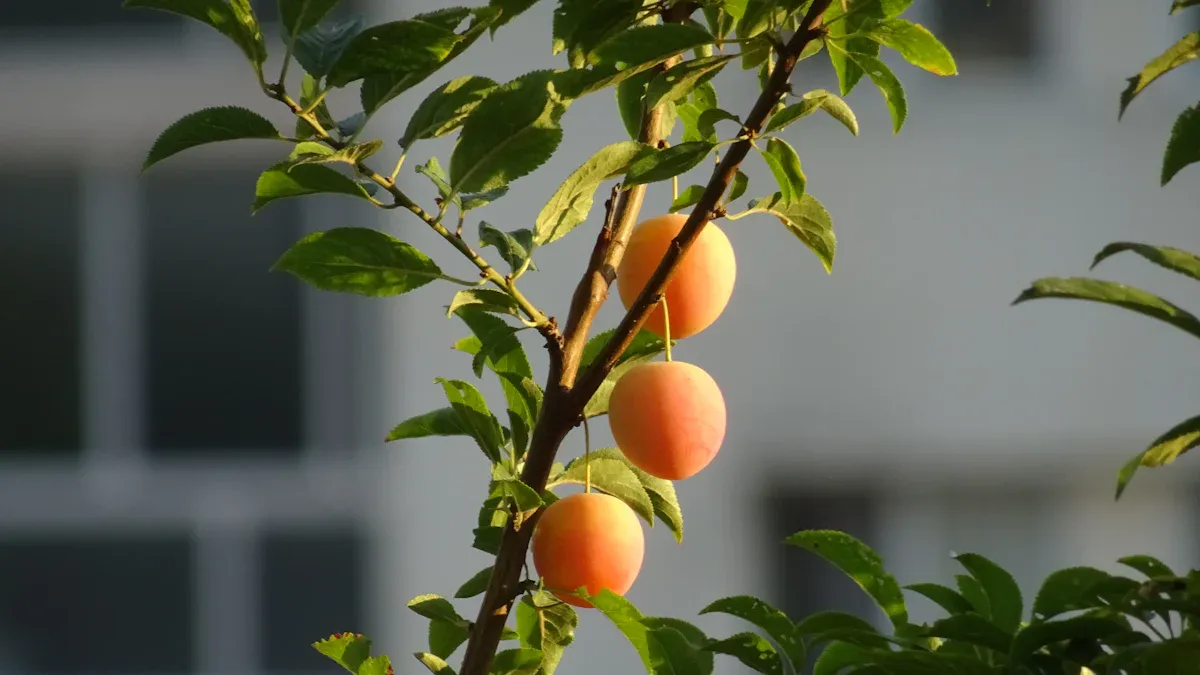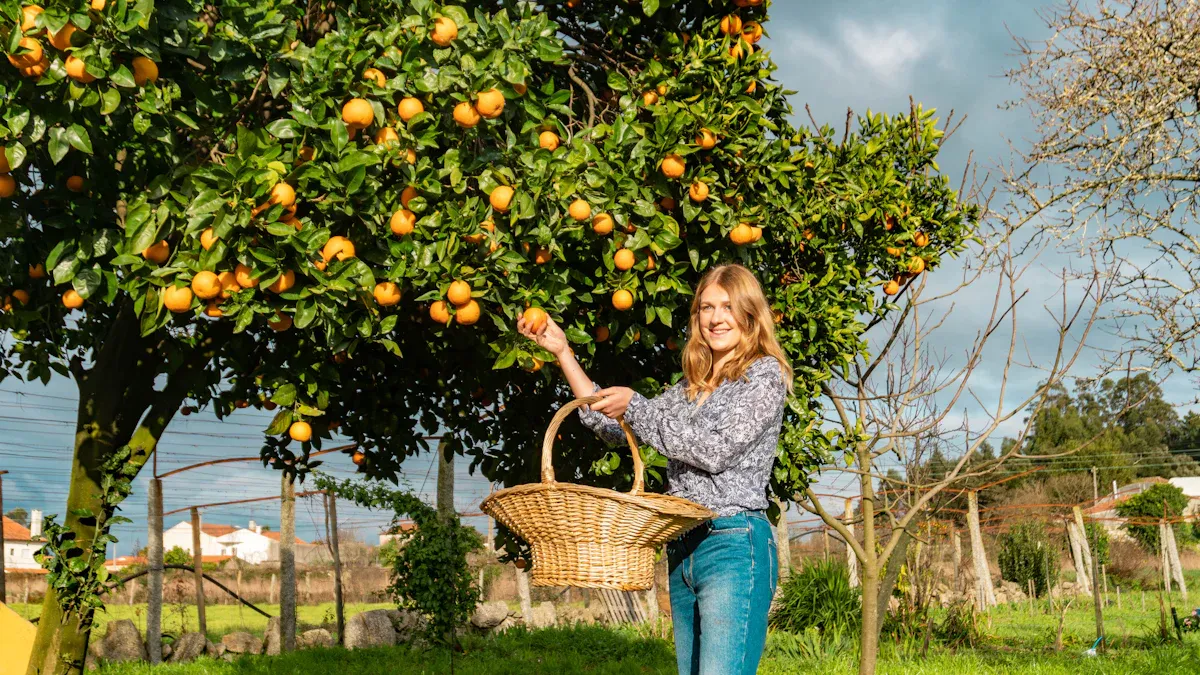
Growing fruits brings joy and satisfaction. Homegrown fruits taste better and offer health benefits. Approximately 30% of households in the United States grow their own fruits. These fruits often contain more nutrients than store-bought options. With the right tips, you can succeed in growing fruits successfully.
Key Takeaways
Select fruit varieties that match your local climate and available space for successful growth.
Prepare your soil by testing its quality and amending it with compost or other nutrients to support healthy plants.
Implement proper watering and fertilization techniques to enhance plant health and maximize fruit yield.
Fruit Selection for Success

Choosing the right fruit varieties is crucial for your success in growing fruits. You must consider your local climate and the space you have available. These factors significantly influence which fruits will thrive in your garden.
Climate Considerations
Your region’s climate plays a vital role in determining which fruit varieties will flourish. Different fruits require specific temperature ranges and chilling hours to produce fruit effectively. For example, apples and pears bloom earlier with rising temperatures, while insufficient chilling hours can lead to poor fruit set.
Here are some key factors to consider:
Temperature Impact: An increase of 0.45°C per decade can advance apple and pear blooming by 1.6 days per decade.
Chilling Hours: Many fruit trees need a certain number of chilling hours to break dormancy. Without this, they may not produce fruit.
Regional Variations: In warmer areas, grape flowering can occur much earlier, affecting yield.
Dr. Curt Rom from the University of Arkansas highlights that climate changes can make growing certain fruits, like apples, impractical in some regions. Therefore, always select cultivars that thrive in your local climate.
Space Requirements
Space is another critical factor when selecting fruit varieties. You need to know how much room each plant requires to grow properly. Here’s a quick reference table for minimum space requirements:
Plant Type | Minimum Space Requirement |
|---|---|
Dwarf apples | 12-15 ft |
Semi dwarf apples | 15-18 ft |
Pears (standard-semi standard) | ~20 ft |
Peaches (standard) | ~18 ft |
Blueberries | 8 ft |
Strawberries | 18 in |
Romance Series cherries | ~10 ft |
Raspberries (red, purple, black) | 3 ft |
Blackberries (thornless semi-erect) | 5 ft |
If you have limited space, consider growing dwarf cultivars or using container gardening techniques. These methods allow you to modify soil conditions and select compact varieties that thrive in smaller areas.
For beginners, starting with soft fruits like strawberries and raspberries is a great idea. They are easy to grow and require less space. Here’s a quick overview of why these fruits are ideal for novice gardeners:
Fruit | Ease of Growth | Additional Notes |
|---|---|---|
Strawberries | Crop the first summer after planting; minimal pruning needed | Only requires trimming back leaves after fruiting. |
Raspberries | Exceptional harvests with minimal effort; easy pruning | Cut back old canes in late winter for new growth. |
Soft fruits not only provide delicious flavors but also offer health benefits. They are rich in vitamins and nutrients, making them a smart choice for your garden.
By carefully considering climate and space, you can select the best fruit varieties for your garden. This thoughtful approach will help you in your journey of growing fruits successfully.
Soil Preparation Techniques
Preparing your soil properly is essential for growing fruits successfully. Healthy soil provides the foundation for strong plants. Start by testing your soil quality to understand its composition and nutrient levels.
Testing Soil Quality
You can assess your soil’s health through various methods. Here’s a table summarizing effective soil testing techniques:
Method | Description |
|---|---|
Sampling Technique | Collect 15-30 subsamples in a random or zig-zag pattern across the area. |
Depth of Sampling | Sample to a depth of 8-12 inches using a soil probe or trowel. |
Frequency of Testing | Conduct soil testing every 1 to 5 years, depending on the crop. |
Representative Sampling | Collect samples from throughout the area of interest to capture variability. |
Submission | Submit samples to the UMN Soil Testing Laboratory for analysis. |
Testing your soil helps you identify deficiencies and allows you to make informed amendments.
Amending the Soil
Once you know your soil’s needs, you can amend it to improve fruit plant growth. Here are some commonly recommended amendments:
Compost or aged manure
Worm castings
Vermiculite and perlite
Mulches
Agricultural lime or elemental sulfur
Compost is particularly beneficial. It enhances all soil types, improves drainage, and increases nutrient availability. However, be cautious with composted manure due to its high nitrogen content, which can lead to excessive foliage growth at the expense of flowering.
Proper drainage is crucial for healthy fruit plants. Excess moisture can lead to root rot, stunted growth, and nutrient deficiencies. To ensure good drainage, avoid planting in low spots and use well-drained soil. When planting, follow these best practices:
Use aged compost in the planting hole.
Dig holes slightly larger than the root system.
Water immediately after planting to eliminate air pockets.
By preparing your soil correctly, you set the stage for thriving fruit plants and a fruitful harvest.
Plant Care for Growing Fruits Successfully

Caring for your fruit plants is essential for a successful harvest. Proper watering and fertilization techniques can significantly impact the health and yield of your plants. Let’s explore effective methods to ensure your fruit plants thrive.
Watering Techniques
Watering your fruit plants correctly is crucial. It helps them develop strong roots and produce healthy fruit. Here are some key points to consider:
Frequency: Different fruit types require varying watering frequencies. Check the table below for guidance:
Fruit Type | Frequency | Method | Tips |
|---|---|---|---|
Citrus Trees | Once or twice a week | Use soaker hose or drip irrigation | Mulch to retain moisture and regulate temperature. |
Stone Fruits | Once a week, twice in heat | Deep watering for deeper roots | Avoid overhead watering to reduce fungal diseases. |
Berries | 2-3 times per week | Drip irrigation or soaker hoses | Check soil moisture during flowering and fruiting. |
Vine Fruits | Once a week, less in cool | Deep watering for drought resilience | Mulch to retain moisture and suppress weeds. |
Impact of Watering: Overwatering can lead to lower crop yields and poor quality. Nutrient leaching from saturated soil can deplete essential nutrients like nitrogen and potassium. This depletion results in stunted growth and fewer fruits. Conversely, underwatering during fruit development can reduce fruit size and moisture content. While the nutritional quality may remain stable, the overall yield suffers.
Fertilization Tips
Fertilizing your fruit plants correctly ensures they receive the nutrients they need for optimal growth. Here are some effective strategies:
Types of Fertilizers: Different fertilizers offer various benefits. Consider the following options:
Fertilizer Type | Key Benefits |
|---|---|
Organic Fertilizers | Derived from natural ingredients, slow-release, improves soil health, promotes microbial activity. |
Synthetic Fertilizers | Provide readily available nutrients, effective for correcting deficiencies, but may harm soil health if overused. |
High-Nitrogen Sources | Essential for growth, includes blood meal and feather meal for increased nitrogen levels. |
Micronutrient Boosters | Supplies trace minerals for flavor and fruit set, includes Azomite and Langbeinite for sweetness. |
Application Timing: The best time to fertilize is early spring, just before buds swell. A second application can occur in early summer. Avoid nitrogen after July to prevent excessive foliage growth.
Signs of Nutrient Deficiencies: Watch for signs that indicate nutrient deficiencies in your plants:
Yellow leaves
Yellow or brown leaf edges
Holes in leaves
Leaves look burnt or scorched
Twisted or misshaped leaves
If you notice these symptoms, conduct a soil test to identify specific deficiencies. For example, apply nitrogen-rich fertilizers for nitrogen deficiency or magnesium sulfate for magnesium deficiency.
Regular maintenance tasks such as weeding and mulching are essential for maximizing the quality and yield of fruit. Manage weeds throughout the year as part of a holistic maintenance program that includes proper irrigation and pest management.
By implementing these watering and fertilization techniques, you can enhance your chances of growing fruits successfully. Your plants will thrive, leading to a bountiful harvest.
Growing fruits at home can be a fulfilling experience. You can enjoy fresh flavors and improve your health. Remember these key points:
Choose the right varieties for your climate and space.
Prepare your soil for optimal growth.
Care for your plants with proper watering and fertilization.
With patience and consistent care, you will reap the rewards of your efforts. Start your fruit-growing journey today and explore popular options like strawberries and blueberries. Happy gardening! 🍓🌱
FAQ
What fruits are easiest to grow for beginners?
Start with strawberries, raspberries, or blueberries. These soft fruits require less space and are simple to care for.
How often should I water my fruit plants?
Water your plants based on their type. Generally, most need watering once a week, more during hot weather.
When is the best time to fertilize fruit plants?
Fertilize in early spring before buds swell. A second application can occur in early summer for optimal growth.


